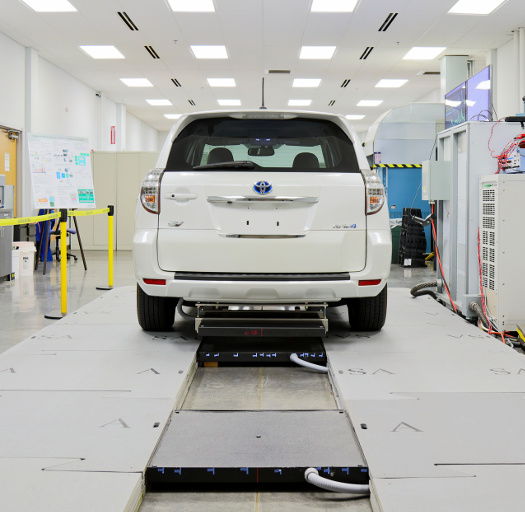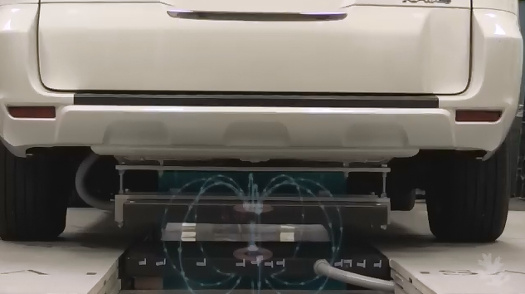 |
| July 05, 2016 | Volume 12 Issue 25 |
Designfax weekly eMagazine
Archives
Partners
Manufacturing Center
Product Spotlight
Modern Applications News
Metalworking Ideas For
Today's Job Shops
Tooling and Production
Strategies for large
metalworking plants
ORNL surges forward with 20-kW wireless charging for vehicles
Editor's Note: If you have the extra 2 minutes, the video below is very informative.
A 20-kilowatt (kW) wireless charging system demonstrated at the Department of Energy's Oak Ridge National Laboratory (ORNL) in Tennessee has achieved 90 percent efficiency at three times the rate of the plug-in systems commonly used for electric vehicles today.
This capability aims to help accelerate the adoption and convenience of electric vehicles. Industry partners from Toyota, Cisco Systems, Evatran, and Clemson University International Center for Automotive Research contributed to the technology development demonstrated at ORNL.

ORNL's 20-kW wireless charging system features 90 percent efficiency.
"We have made tremendous progress from the lab proof-of-concept experiments a few years ago," said Madhu Chinthavali, ORNL Power Electronics Team lead. "We have set a path forward that started with solid engineering, design, scale-up, and integration into several Toyota vehicles. We now have a technology that is moving closer to being ready for the market."
ORNL's power electronics team achieved this world-first 20-kW wireless charging system for passenger cars by developing a unique architecture that included an ORNL-built inverter, isolation transformer, vehicle-side electronics, and coupling technologies in less than three years. For the demonstration, researchers integrated the single-converter system into an electric Toyota RAV4 equipped with an additional 10-kWh battery.

The researchers are already looking ahead to their next target of 50-kW wireless charging, which would match the power levels of commercially available plug-in quick chargers. Providing the same speed with the convenience of wireless charging could increase consumer acceptance of electric vehicles and is considered a key enabler for hands-free, autonomous vehicles. Higher power levels are also essential for powering larger vehicles such as trucks and buses.
As the researchers advance their system to higher power levels, one of their chief considerations is safety.
"The high-frequency magnetic fields employed in power transfer across a large air gap are focused and shielded," Chinthavali said. "This means that magnetic fringe fields decrease rapidly to levels well below limits set by international standards, including inside the vehicle, to ensure personal safety."
VIDEO: A 20-kW wireless charging system demonstrated at Department of Energy's Oak Ridge National Laboratory has achieved 90 percent efficiency and at three times the rate of the plug-in systems commonly used for electric vehicles today.
Convenience and simplicity are at the heart of the ORNL system, which places a strong emphasis on radio communications in the power-regulation feedback channel augmented by software control algorithms. The result is minimization of vehicle on-board complexity as ORNL and partners pursue the long-range goal of connected vehicles, wireless communications, and in-motion charging. While the team's initial focus has been static, or motionless, wireless charging, the researchers also evaluated and demonstrated the system's dynamic charging capabilities.
But how fast are we talking about when we talk about improved vehicle charging times?
"The charging time really depends on the battery capacity of the vehicle," said Omer C. Onar, PhD, R&D Staff, Power Electronics and Electric Machinery Group, ORNL. "For example, if the vehicle has a 10-kWh battery pack (like Chevy Volt), it could be charged in 30 minutes with a 20-kW charger (10 kWh/20 kW=0.5 hr).
"Usually, for fast charging, the maximum battery state of charge is limited to 80 percent, and batteries are not discharged below 20 percent state of charge. This gives a total usable state-of-charge window of 60 percent. Therefore, practically, a 10-kWh battery can be charged in 18 minutes (10 x 60 percent = 6 kWh and 6 kWh/20kW = 0.3 hr = 18 min.). In another example, Nissan Leaf has about ~20-kWh capacity. Assuming the same state-of-charge window, it would take about 36 minutes to charge a Leaf from 20 percent to 80 percent state of charge (20 kWh x 60 percent/20 kW = 36 min.). Similar math can be done for other vehicles with different sizes of battery packs."
But the 50-kW charger will really shorten the charging time. Using the examples above, said Omer, "These charging times can be reduced by a factor of 20/50=0.4 (for example ~7 minutes instead of 18 minutes, and 15 minutes instead of 36 minutes)."
The Energy Efficiency and Renewable Energy's Vehicle Technologies Office provided funding for this competitively selected project as part of a broad portfolio in support of DOE's EV Everywhere Grand Challenge, which aims to make plug-in electric vehicles as affordable to own and operate as today's gasoline-powered vehicles by 2022.
"Wireless power transfer is a paradigm shift in electric vehicle charging that offers the consumer an autonomous, safe, efficient, and convenient option to plug-in charging," said David Smith, vehicle systems program manager. "The technology demonstrated today is a stepping stone toward electrified roadways where vehicles could charge on the go."
Toyota provided several vehicles for the research, including RAV4s, a Scion, and a plug-in Prius.
Other members of the ORNL project team are current staff members Steven Campbell, Paul Chambon, Omer Onar, Burak Ozpineci, Larry Seiber, Lixin Tang, Cliff White, and Randy Wiles, as well as retired staff members Curt Ayers, Chester Coomer, and John Miller. The research and demonstration took place at ORNL's National Transportation Research Center, a DOE User Facility.
UT-Battelle manages ORNL for the DOE's Office of Science. For more information, please visit http://science.energy.gov/.
Source: Oak Ridge National Laboratory
Published April 2016
Rate this article
View our terms of use and privacy policy
